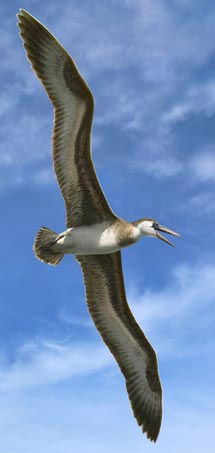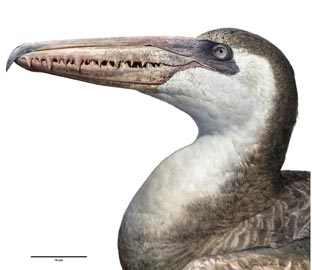Giant “Toothed” Birds Once Soared over Australia According to New Study
Melbourne Fossil Discovery Hints at Rich and Diverse Ecosystem in Australia’s Past
Museum Victoria palaeontologist Dr Erich Fitzgerald has discovered the first Australian fossils of bizarre bony-toothed birds – extinct giants with five metre wingspans. The five-million-year-old bone of Pelagornis is a new element in an extraordinary fossil fauna uncovered in Melbourne.
Giant “Toothed” Birds
Published today in the Journal of Vertebrate Palaeontology, this important discovery is the first evidence that these gigantic prehistoric birds once soared the skies of coastal Australia. The Pelagornithidae family, commonly known as bony-toothed birds due to their tooth-like projections on their beak, had wingspans of over five metres. The species discovered in Australia, Pelagornis, was one of the largest flying animals to exist on Earth after the extinction of pterosaurs 66 million years ago.
Senior Curator of Vertebrate Palaeontology at the Museum Victoria, Dr Erich Fitzgerald stated:
“Bony-toothed birds are enigmatic extinct seabirds with a long history spanning over 50 million years. They were previously known from all continents except Australia. The fact that they existed in Australia not that long ago changes our understanding of the evolution of seabirds in this part of the world.”
Dr Fitzgerald and the Fossilised Pelagornis Bone
Picture credit: Museum Victoria / Photographer: Jon Augier
The fossil leg bone found in Beaumaris Bay (South Australia) not only provides evidence that these bony-toothed birds were globally distributed, but also offers new insight into the diverse marine life in our seas at the time. The tooth-like structures in the jaws are not true teeth, but serrations of the beak itself that permitted these birds to catch and hold fish and cephalopods such as squid in their beaks.
Dr Fitzgerald went onto explain:
“We knew next to nothing about the evolution of seabirds in Australia. This finding shows us that there has been a significant change in seabird diversity between five million years ago and now. Pelagornis is just one of Victoria’s long-lost marine megafauna, which included bus-sized sharks, giant penguins, killer sperm whales and dugongs. Life was larger back then!”
According to the co-author on the paper, Mr Travis Park, Honours student at Museum Victoria and Deakin University, “the extinction of these diverse large sea creatures was perhaps linked to long-term changes in their environment.”
Pliocene Terror
Pliocene Terror – Giant “Toothed” Sea Birds
Picture credit: Museum Victoria / Artist: Peter Trusler
Travis added:
“The current coastal seas off southeast Australia are less nutrient-rich than previously, and therefore no longer support as many large marine animals.”
Although this fossil discovery shows how much there is still to learn about the evolution and extinction, of these strange giant birds, this research gives us a glimpse into a time when southern Australian sea life was more spectacular than at present.
To read about the discovery of more giant Pelagornis fossils from the Southern Hemisphere (Chile) click the link below:
More Pelagornis fossils discovered: Bird with a “Toothy Grin”.
A Close up of the Vicious “Toothed Beak” of Pelagornis
Picture credit: Museum Victoria / Artist: Peter Trusler
Scale bar in picture = 10 cm
Everything Dinosaur is grateful to Museums Victoria for their help in compiling this article.
Visit Everything Dinosaur’s website to purchase models of prehistoric animals: Prehistoric Animal Figures and Scale Models of Dinosaurs.




